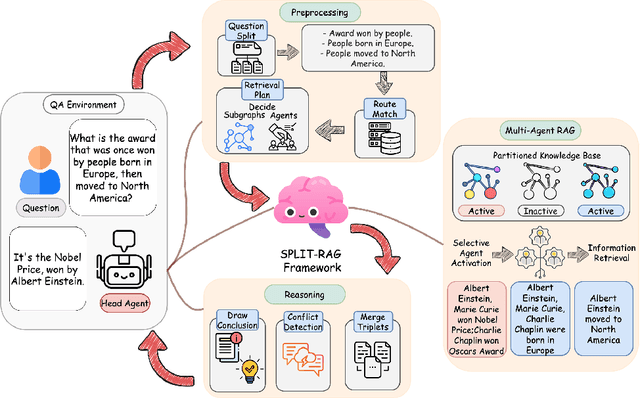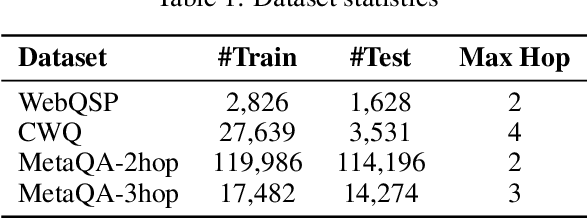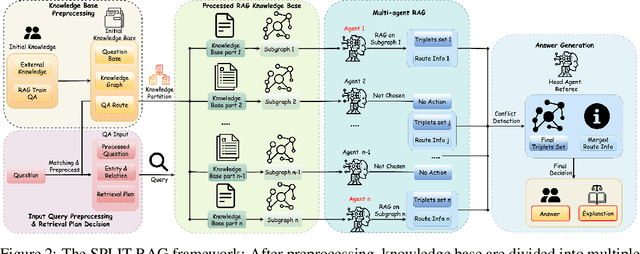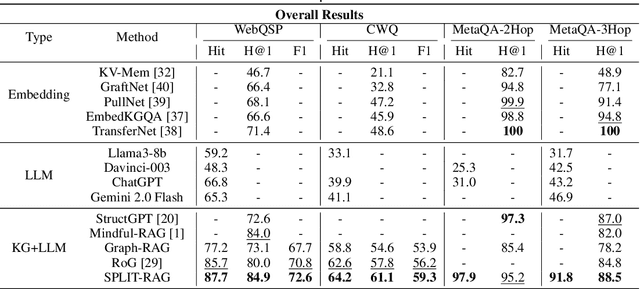Hao Xue
Resolving Ambiguity in Gaze-Facilitated Visual Assistant Interaction Paradigm
Sep 26, 2025Abstract:With the rise in popularity of smart glasses, users' attention has been integrated into Vision-Language Models (VLMs) to streamline multi-modal querying in daily scenarios. However, leveraging gaze data to model users' attention may introduce ambiguity challenges: (1) users' verbal questions become ambiguous by using pronouns or skipping context, (2) humans' gaze patterns can be noisy and exhibit complex spatiotemporal relationships with their spoken questions. Previous works only consider single image as visual modality input, failing to capture the dynamic nature of the user's attention. In this work, we introduce GLARIFY, a novel method to leverage spatiotemporal gaze information to enhance the model's effectiveness in real-world applications. Initially, we analyzed hundreds of querying samples with the gaze modality to demonstrate the noisy nature of users' gaze patterns. We then utilized GPT-4o to design an automatic data synthesis pipeline to generate the GLARIFY-Ambi dataset, which includes a dedicated chain-of-thought (CoT) process to handle noisy gaze patterns. Finally, we designed a heatmap module to incorporate gaze information into cutting-edge VLMs while preserving their pretrained knowledge. We evaluated GLARIFY using a hold-out test set. Experiments demonstrate that GLARIFY significantly outperforms baselines. By robustly aligning VLMs with human attention, GLARIFY paves the way for a usable and intuitive interaction paradigm with a visual assistant.
TradingGroup: A Multi-Agent Trading System with Self-Reflection and Data-Synthesis
Aug 25, 2025Abstract:Recent advancements in large language models (LLMs) have enabled powerful agent-based applications in finance, particularly for sentiment analysis, financial report comprehension, and stock forecasting. However, existing systems often lack inter-agent coordination, structured self-reflection, and access to high-quality, domain-specific post-training data such as data from trading activities including both market conditions and agent decisions. These data are crucial for agents to understand the market dynamics, improve the quality of decision-making and promote effective coordination. We introduce TradingGroup, a multi-agent trading system designed to address these limitations through a self-reflective architecture and an end-to-end data-synthesis pipeline. TradingGroup consists of specialized agents for news sentiment analysis, financial report interpretation, stock trend forecasting, trading style adaptation, and a trading decision making agent that merges all signals and style preferences to produce buy, sell or hold decisions. Specifically, we design self-reflection mechanisms for the stock forecasting, style, and decision-making agents to distill past successes and failures for similar reasoning in analogous future scenarios and a dynamic risk-management model to offer configurable dynamic stop-loss and take-profit mechanisms. In addition, TradingGroup embeds an automated data-synthesis and annotation pipeline that generates high-quality post-training data for further improving the agent performance through post-training. Our backtesting experiments across five real-world stock datasets demonstrate TradingGroup's superior performance over rule-based, machine learning, reinforcement learning, and existing LLM-based trading strategies.
ZARA: Zero-shot Motion Time-Series Analysis via Knowledge and Retrieval Driven LLM Agents
Aug 06, 2025Abstract:Motion sensor time-series are central to human activity recognition (HAR), with applications in health, sports, and smart devices. However, existing methods are trained for fixed activity sets and require costly retraining when new behaviours or sensor setups appear. Recent attempts to use large language models (LLMs) for HAR, typically by converting signals into text or images, suffer from limited accuracy and lack verifiable interpretability. We propose ZARA, the first agent-based framework for zero-shot, explainable HAR directly from raw motion time-series. ZARA integrates an automatically derived pair-wise feature knowledge base that captures discriminative statistics for every activity pair, a multi-sensor retrieval module that surfaces relevant evidence, and a hierarchical agent pipeline that guides the LLM to iteratively select features, draw on this evidence, and produce both activity predictions and natural-language explanations. ZARA enables flexible and interpretable HAR without any fine-tuning or task-specific classifiers. Extensive experiments on 8 HAR benchmarks show that ZARA achieves SOTA zero-shot performance, delivering clear reasoning while exceeding the strongest baselines by 2.53x in macro F1. Ablation studies further confirm the necessity of each module, marking ZARA as a promising step toward trustworthy, plug-and-play motion time-series analysis. Our codes are available at https://github.com/zechenli03/ZARA.
Generate the Forest before the Trees -- A Hierarchical Diffusion model for Climate Downscaling
Jun 24, 2025Abstract:Downscaling is essential for generating the high-resolution climate data needed for local planning, but traditional methods remain computationally demanding. Recent years have seen impressive results from AI downscaling models, particularly diffusion models, which have attracted attention due to their ability to generate ensembles and overcome the smoothing problem common in other AI methods. However, these models typically remain computationally intensive. We introduce a Hierarchical Diffusion Downscaling (HDD) model, which introduces an easily-extensible hierarchical sampling process to the diffusion framework. A coarse-to-fine hierarchy is imposed via a simple downsampling scheme. HDD achieves competitive accuracy on ERA5 reanalysis datasets and CMIP6 models, significantly reducing computational load by running on up to half as many pixels with competitive results. Additionally, a single model trained at 0.25{\deg} resolution transfers seamlessly across multiple CMIP6 models with much coarser resolution. HDD thus offers a lightweight alternative for probabilistic climate downscaling, facilitating affordable large-ensemble high-resolution climate projections. See a full code implementation at: https://github.com/HDD-Hierarchical-Diffusion-Downscaling/HDD-Hierarchical-Diffusion-Downscaling.
STOAT: Spatial-Temporal Probabilistic Causal Inference Network
Jun 12, 2025Abstract:Spatial-temporal causal time series (STC-TS) involve region-specific temporal observations driven by causally relevant covariates and interconnected across geographic or network-based spaces. Existing methods often model spatial and temporal dynamics independently and overlook causality-driven probabilistic forecasting, limiting their predictive power. To address this, we propose STOAT (Spatial-Temporal Probabilistic Causal Inference Network), a novel framework for probabilistic forecasting in STC-TS. The proposed method extends a causal inference approach by incorporating a spatial relation matrix that encodes interregional dependencies (e.g. proximity or connectivity), enabling spatially informed causal effect estimation. The resulting latent series are processed by deep probabilistic models to estimate the parameters of the distributions, enabling calibrated uncertainty modeling. We further explore multiple output distributions (e.g., Gaussian, Student's-$t$, Laplace) to capture region-specific variability. Experiments on COVID-19 data across six countries demonstrate that STOAT outperforms state-of-the-art probabilistic forecasting models (DeepAR, DeepVAR, Deep State Space Model, etc.) in key metrics, particularly in regions with strong spatial dependencies. By bridging causal inference and geospatial probabilistic forecasting, STOAT offers a generalizable framework for complex spatial-temporal tasks, such as epidemic management.
A Probabilistic Framework for Imputing Genetic Distances in Spatiotemporal Pathogen Models
Jun 10, 2025Abstract:Pathogen genome data offers valuable structure for spatial models, but its utility is limited by incomplete sequencing coverage. We propose a probabilistic framework for inferring genetic distances between unsequenced cases and known sequences within defined transmission chains, using time-aware evolutionary distance modeling. The method estimates pairwise divergence from collection dates and observed genetic distances, enabling biologically plausible imputation grounded in observed divergence patterns, without requiring sequence alignment or known transmission chains. Applied to highly pathogenic avian influenza A/H5 cases in wild birds in the United States, this approach supports scalable, uncertainty-aware augmentation of genomic datasets and enhances the integration of evolutionary information into spatiotemporal modeling workflows.
Divide by Question, Conquer by Agent: SPLIT-RAG with Question-Driven Graph Partitioning
May 20, 2025



Abstract:Retrieval-Augmented Generation (RAG) systems empower large language models (LLMs) with external knowledge, yet struggle with efficiency-accuracy trade-offs when scaling to large knowledge graphs. Existing approaches often rely on monolithic graph retrieval, incurring unnecessary latency for simple queries and fragmented reasoning for complex multi-hop questions. To address these challenges, this paper propose SPLIT-RAG, a multi-agent RAG framework that addresses these limitations with question-driven semantic graph partitioning and collaborative subgraph retrieval. The innovative framework first create Semantic Partitioning of Linked Information, then use the Type-Specialized knowledge base to achieve Multi-Agent RAG. The attribute-aware graph segmentation manages to divide knowledge graphs into semantically coherent subgraphs, ensuring subgraphs align with different query types, while lightweight LLM agents are assigned to partitioned subgraphs, and only relevant partitions are activated during retrieval, thus reduce search space while enhancing efficiency. Finally, a hierarchical merging module resolves inconsistencies across subgraph-derived answers through logical verifications. Extensive experimental validation demonstrates considerable improvements compared to existing approaches.
Massive-STEPS: Massive Semantic Trajectories for Understanding POI Check-ins -- Dataset and Benchmarks
May 19, 2025Abstract:Understanding human mobility through Point-of-Interest (POI) recommendation is increasingly important for applications such as urban planning, personalized services, and generative agent simulation. However, progress in this field is hindered by two key challenges: the over-reliance on older datasets from 2012-2013 and the lack of reproducible, city-level check-in datasets that reflect diverse global regions. To address these gaps, we present Massive-STEPS (Massive Semantic Trajectories for Understanding POI Check-ins), a large-scale, publicly available benchmark dataset built upon the Semantic Trails dataset and enriched with semantic POI metadata. Massive-STEPS spans 12 geographically and culturally diverse cities and features more recent (2017-2018) and longer-duration (24 months) check-in data than prior datasets. We benchmarked a wide range of POI recommendation models on Massive-STEPS using both supervised and zero-shot approaches, and evaluated their performance across multiple urban contexts. By releasing Massive-STEPS, we aim to facilitate reproducible and equitable research in human mobility and POI recommendation. The dataset and benchmarking code are available at: https://github.com/cruiseresearchgroup/Massive-STEPS
SOCIA: An End-to-End Agentic Framework for Automated Cyber-Physical-Social Simulator Generation
May 17, 2025Abstract:This paper introduces SOCIA (Simulation Orchestration for Cyber-physical-social Intelligence and Agents), a novel end-to-end framework leveraging Large Language Model (LLM)-based multi-agent systems to automate the generation of high-fidelity Cyber-Physical-Social (CPS) simulators. Addressing the challenges of labor-intensive manual simulator development and complex data calibration, SOCIA integrates a centralized orchestration manager that coordinates specialized agents for tasks including data comprehension, code generation, simulation execution, and iterative evaluation-feedback loops. Through empirical evaluations across diverse CPS tasks, such as mask adoption behavior simulation (social), personal mobility generation (physical), and user modeling (cyber), SOCIA demonstrates its ability to produce high-fidelity, scalable simulations with reduced human intervention. These results highlight SOCIA's potential to offer a scalable solution for studying complex CPS phenomena
Optimizing Electric Vehicle Charging Station Locations: A Data-driven System with Multi-source Fusion
Apr 18, 2025Abstract:With the growing electric vehicles (EVs) charging demand, urban planners face the challenges of providing charging infrastructure at optimal locations. For example, range anxiety during long-distance travel and the inadequate distribution of residential charging stations are the major issues many cities face. To achieve reasonable estimation and deployment of the charging demand, we develop a data-driven system based on existing EV trips in New South Wales (NSW) state, Australia, incorporating multiple factors that enhance the geographical feasibility of recommended charging stations. Our system integrates data sources including EV trip data, geographical data such as route data and Local Government Area (LGA) boundaries, as well as features like fire and flood risks, and Points of Interest (POIs). We visualize our results to intuitively demonstrate the findings from our data-driven, multi-source fusion system, and evaluate them through case studies. The outcome of this work can provide a platform for discussion to develop new insights that could be used to give guidance on where to position future EV charging stations.
 Add to Chrome
Add to Chrome Add to Firefox
Add to Firefox Add to Edge
Add to Edge